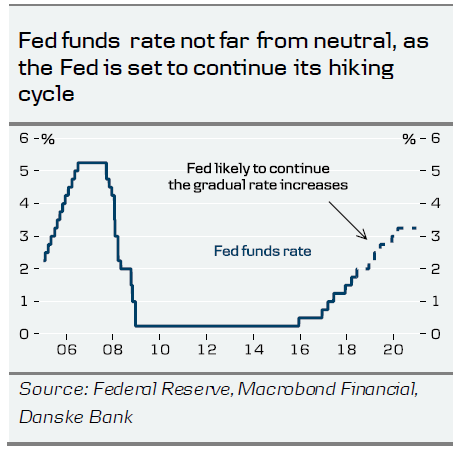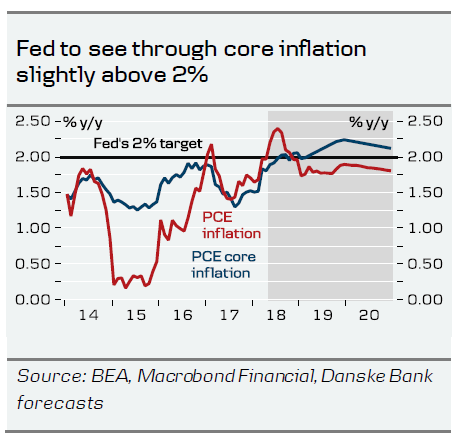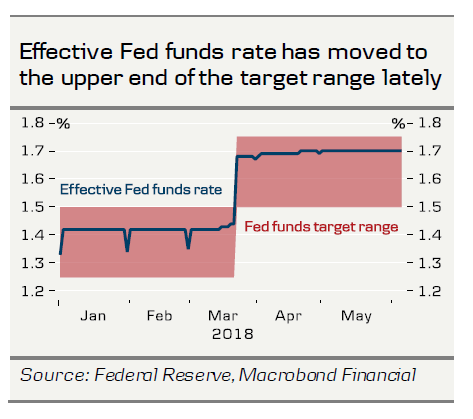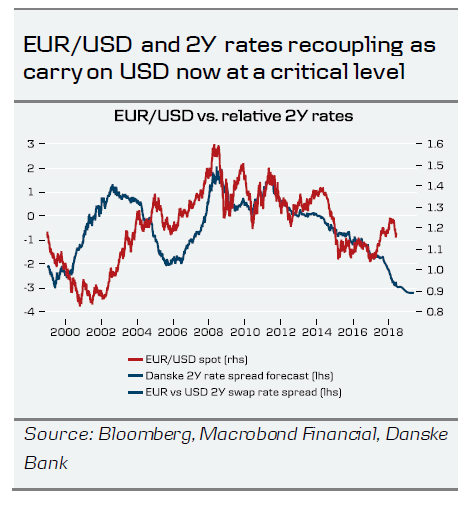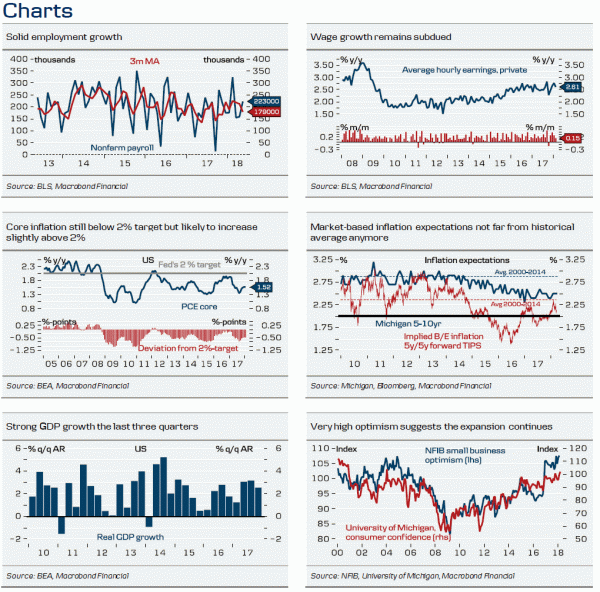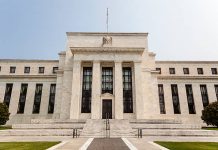- We expect the Fed to hike the target range by 25bp to 1.75%-2.00% next week without making big changes to the dot plot.
- The Fed is set to recognise that the Fed funds rate is close to the longer-run dot by stating ‘monetary policy is modestly accommodative’ (modestly being a new word), which is not a change in policy strategy; it just reflects the hiking cycle has come a long way.
- We still forecast three hikes this year with risk skewed towards four.
- Fed is adding to carry appeal of the USD and we look for EUR/USD to remain in the 1.15-1.21 range on a 6M horizon (see page 2).
In line with consensus and market pricing, we expect the Fed to hike the target range by 25bp to 1.75-2.00% at next week’s meeting (the interest rate on excess reserves (IOER) has usually been at the high end of the range but is likely to be hiked by only 20bp as a technical adjustment).
We do not think the Fed is going to make big changes to its current dot plot and it will continue to show a more or less even split between those signalling three or four hikes this year. As only one member needs to raise its dot from three to four hikes, one should not necessarily interpret it as a hawkish signal if the median dot is lifted from three to four hikes. At least a couple of committee members need to upgrade their outlook before we would interpret it as a hawkish shift. The Fed has adopted, at least in the short run, a de facto price level target in the sense that it has explicitly stated that it can tolerate inflation to overshoot 2% temporarily, as inflation has undershot the 2% target for a long time. We think that the updated inflation projection will still reflect this view and that it is unlikely that members, who signalled four hikes in March, are going to lift their dots from 4 to 5 hikes. The median dot for 2019 is likely unchanged at three more hikes and the Fed will continue to signal that it will raise the Fed funds rate above the natural rate, as it times to hit the brakes due to more expansionary fiscal policy. Our base case is one additional hike in December but the risk is skewed towards two hikes (i.e. three hikes this year with risk skewed towards four).
As we are moving closer to the Fed’s estimate of the natural rate of interest (where monetary policy is neither expansionary nor contractionary, currently estimated at 2.875%), we think the Fed is going to change its statement by stating: ‘The stance of monetary policy remains MODESTLY accommodative […]’. This is not a change in the Fed’s p olicy strategy , as it is more or less on autop ilot, but it reflects that the hiking cycle has lasted for a while now and we are not many hikes away from the longer-run dot. Already last year, former Fed chair Janet Yellen said monetary policy was close to being neutral. However, markets may interpret this as dovish, as it could be seen as a sign that the Fed is soon done hiking. We disagree and still believe markets are priced too softly further out the curve. Otherwise, we do not expect any major changes to the statement, as the Fed will repeat it will continue its gradual hiking cycle.
In the Q&A, we are mostly interested in questions about the target for the future level of the balance sheet (QT is open-ended at the moment) and whether the Fed has started a more formal investigation of pros and cons of shifting target officially to a price level target. In addition, it will be important to monitor whether a 20bp hike of IOER instead of 25bp will be sufficient to reign in the effective Fed funds rate and bring it closer to the middle of the target range. Alternatively, if the Fed has considered other measures to regain control of it.
FX: Fed adding to carry appeal of USD
While a Fed June hike is widely expected and as such should not give rise to a significant market reaction, a key issue will be whether markets sense that the Fed is closer to being done on hikes. We do not think that is the case and maintain that the market is pricing the Fed too softly beyond 2018. To the extent that the recent recoupling between the USD and US yields continues, this suggests that the USD will stay supported for some time still. Indeed, the carry on long USD positions appears to have reached a key threshold, yielding around 3% p.a. versus the EUR, which in our view makes it likely that relative rates are likely to stick around as driver. As such, our sense of a Fed on autopilot should merely add to the carry appeal of the USD at the June meeting. Adding a hesitant ECB, which we think is unlikely to make an announcement in June on ending QE, the recent rebound in EUR/USD should be halted by the two central banks next week. We look for broadly the 1.15-1.21 range to be sustained on a 6M horizon.




